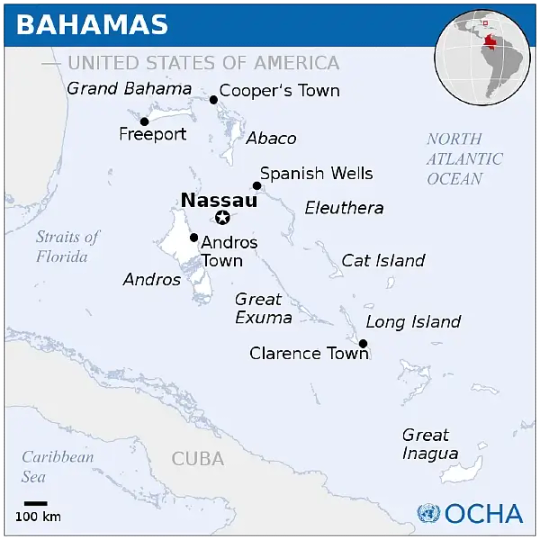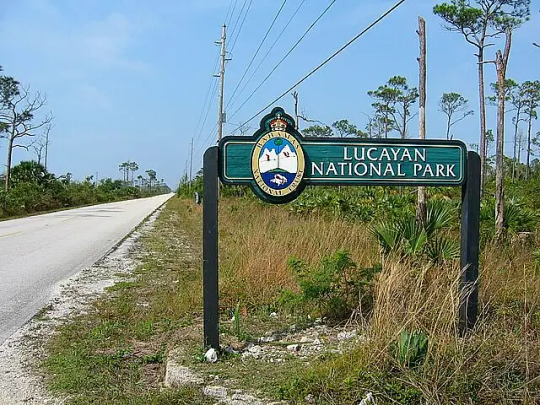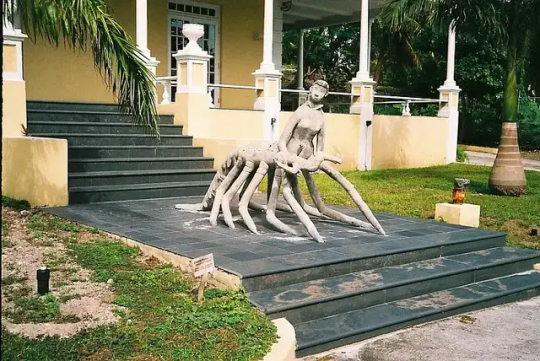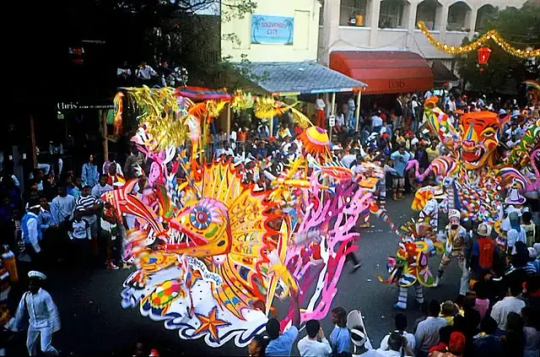#BestislandsintheBahamas
Text
Exploring the Bahamas: A Journey to Paradise
Introduction
Nestled in the crystal-clear waters of the Caribbean, you'll discover a tropical paradise that beckons travelers with its pristine beaches, vibrant culture, and endless sunshine. Welcome to the Bahamas, where every moment spent here is like stepping into a postcard-worthy dream. Whether you're seeking relaxation on powdery white sands or adventure beneath the turquoise waves, this enchanting archipelago offers something for everyone.

The Bahamas Location Map. Photo by UNOCHA.
Where Are the Bahamas?
A Tropical Oasis in the Western Atlantic
The Bahamas are located in the western Atlantic Ocean, nestling between Florida and Cuba. Spanning an area of over 100,000 square miles, the archipelago boasts nearly 700 coral islands and cays, each with its own unique charm and appeal. While only around 30 of these islands are inhabited, the Bahamas' allure extends across the entire archipelago.
Getting to the Bahamas
A Quick and Simple Journey
One of the advantages of being located so close to North America is that getting to the Bahamas is quick and simple. There are short flights from major U.S. cities like Miami or Fort Lauderdale, or you can choose to travel to the islands by ferry.
Ideal for Floridians
The Bahamas offers a picturesque escape just off the coast of Florida, making it an ideal vacation destination for many Floridians. Located just 50 miles east of Miami, getting to the Bahamas is relatively quick and easy. The proximity between the two places allows for various modes of travel that cater to different preferences and budgets.

Balearia Bahamas Express. Photo by Xemenendura. Wikimedia.
How Can You Get to the Bahamas?
One popular way to reach the Bahamas from Florida is by air travel. Several airlines operate regular flights from major cities in Florida, such as Miami and Fort Lauderdale, to airports in Nassau or Freeport. These flights typically take around less than an hour, making it a convenient option for those looking to quickly immerse themselves in Bahamian culture.
There are flights to the Bahamas from many capital cities worldwide. The Bahamas has 20 international airports welcoming regularly scheduled flights from around the world. There are direct flights from most European capitals. British Airways offers direct Bahamas flights from London (LHR) to Nassau four times a week.
With a nine-hour flight time and a five-hour time difference between the Bahamas and the UK, it's often possible to leave in the morning and be on the beach by the afternoon. Travelers flying into Nassau have easy access to fast, connecting flights to dozens of Out Islands (also known as The Family Islands), and private charter service is readily available.
For those who prefer a more leisurely journey, traveling by boat is another viable option. Numerous cruise lines offer trips from ports in southern Florida straight to the Bahamas. Depending on your departure point, these cruises can vary in length from just a few days to over a week, with voyages filled with onboard entertainment and activities. Plus, arriving by sea allows travelers ample time to soak up stunning ocean views and enjoy exciting stops along the way.

Lucayan National Park, Bahamas. Photo by Jesper Rautell Balle. Wikimedia.
History of the Bahamas
A Tapestry of Time
The history of the Bahamas is rich and diverse, with its roots dating back thousands of years. The islands were first inhabited by indigenous peoples known as the Lucayans who lived there long before Christopher Columbus arrived in 1492.
The Lucayan Legacy
The Lucayans were a highly advanced civilization with a complex social structure and rich cultural traditions. They were skilled seafarers and navigated across vast stretches of water to trade with other nearby Caribbean islands. Their expert pottery-making, farming techniques, and impressive architectural skills are evidence of their craftsmanship and ingenuity.
The European Era
Tragically, after European colonization began, diseases brought by these foreign invaders decimated the Lucayan population. Many were enslaved or forced into labor by European settlers, while others fled or died due to maltreatment and disease. Some descendants of the original Lucayan people still reside in settlements on certain Bahamian islands today.
In the early 17th century, Europeans established colonies in the Bahamas. Among these European colonizers were the French, who claimed parts of the islands in 1564 but abandoned their settlements a few years later due to conflicts with Spanish fleets.
The Portuguese also made attempts to settle in the Bahamas, but their efforts were short-lived. It wasn't until 1629 that England established a permanent settlement on New Providence Island, making it one of Britain's oldest colonies.
A Turbulent History
During this time, conflict between European powers often spilled over into the Bahamas. These struggles resulted in several changes of control over the islands throughout history - British rule was interrupted by periods of Spanish ownership and even invasion from pirates.
The road to independence was not an easy one for the Bahamas. After centuries under British rule, calls for political self-determination began to grow stronger in the mid-20th century. In 1964, local elections were held, and Premier Lynden Pindling became the leader of a majority black government.
Four years later, negotiations with Britain led to a new constitution granting internal self-government while retaining ties with Britain as an independent Commonwealth realm. Finally, on July 10th, 1973, the Bahamas achieved full independence – marking an important milestone in their history.
A Democratic Nation
Since gaining independence, democracy has played a fundamental role in shaping governance in the Bahamas. The country operates as a parliamentary democracy within the Commonwealth framework. It utilizes regular elections where citizens have the opportunity to vote for their representatives.

Watling's Blue Hole on San Salvador Island, Bahamas. Photo by Mark Peter. Flickr.
Geology of the Bahamas
A Geological Wonder
The Bahamas comprises over 700 islands and cays, primarily consisting of limestone, a sedimentary rock that forms from the accumulation of organic materials and shells of marine organisms. The unique nature of these limestone formations stems from their origins as ancient coral reefs dating back millions of years.
Blue Holes and Subterranean Secrets
A hidden geological marvel lies beneath the crystal-clear waters surrounding these islands. The Bahamas sits on the boundary between two tectonic plates. The North American Plate and the Caribbean Plate.
This tectonic activity has resulted in various intriguing features, including underwater sinkholes known as blue holes. These deep, circular structures are believed to have formed during glacial periods when lower sea levels allowed freshwater to dissolve portions of the porous limestone rock.
The Subterranean Wonders
Furthermore, exploring this diverse archipelago unveils more than just lush beaches; it reveals a treasure trove of minerals too. Although not extensively explored or exploited, Bahamian geology indicates significant mineral potential, including deposits such as aragonite, salt pans, and possible oil reserves beneath its expansive marine territory.
Limestone Caves
The limestone caves of the Bahamas are a geological wonder that has fascinated scientists for years. These caves, formed millions of years ago when sea levels were much lower, result in a breathtaking underground landscape with intricate formations and stunning stalactites hanging from the ceilings.
One interesting feature of these limestone caves is their connection to freshwater resources on the islands. As rainwater seeps through the porous rock, it forms underground rivers and lakes within the caves. These hidden bodies of water not only provide habitats for various species of fish and other aquatic life but also serve as crucial sources of fresh drinking water for local communities. Intricate cave networks with chambers and passageways stretch for miles beneath the surface.
Exploring these remarkable limestone caves offers an opportunity to witness nature's ingenuity at work while unraveling mysteries from past eons. Studying ancient fossils preserved in these caves and understanding how freshwater systems interact with cavernous landscapes offer opportunities to learn more about both our planet's history and its delicate ecological balance through an examination of these underground wonders.

Sculpture outside the National Art Gallery of the Bahamas. Photo by Mettacitta. Flickr.
Culture of the Bahamas
A Cultural Melting Pot
Despite this tumultuous past, the culture of the Bahamas is deeply rooted in its rich artistic traditions, particularly in the fields of art, sculpture, and pottery.
Vibrant Art Scene
The country's vibrant art scene showcases a unique blend of influences from African, European, and Indigenous cultures. These are characterized by vibrant colors and intricate designs: artists draw inspiration from their natural surroundings, creating artworks that depict the stunning landscapes and marine life that surrounds them.
The World of Sculpture
Sculpture also holds a prominent place in Bahamian culture, with many talented sculptors. From statues depicting historical figures to abstract sculptures inspired by nature, these creations offer glimpses into the soul of this Caribbean nation. It is fascinating to see how each sculptor brings their personal touch to their work while simultaneously paying homage to their cultural heritage.
Pottery as Tradition and Art
Pottery is yet another aspect of Bahamian culture that deserves recognition. The craft has been passed down through generations for centuries and remains an essential part of daily life for many locals. In addition to practical items like bowls and vases, the pottery also plays a role in preserving traditional storytelling techniques through cave drawings or symbolic motifs etched onto clay surfaces. By exploring Bahamian pottery techniques, one can gain insight into the history and evolution of this fascinating island nation.
A Musical Tapestry
Let's not forget the musical heritage of the Bahamas. With influences from Africa, Europe, and indigenous Bahamian traditions, the music here has evolved into a distinct sound that captivates both locals and visitors alike.
The Rhythm of Junkanoo
One genre that stands out is Junkanoo music. Junkanoo, a traditional Bahamian festival celebrated around Christmas time, features groups of costumed performers parading through the streets while playing rhythmic percussion instruments such as drums, cowbells, whistles, and brass instruments. The energy and exuberance of Junkanoo music are infectious, with its lively beats and syncopated rhythms creating an irresistible urge to dance.
The Unique Sound of Rake and Scrape
Bahamian Rake and Scrape is another unique genre that showcases the country’s musical creativity. It combines African rhythms with European accordion melodies in a distinctive fusion that sets it apart from other Caribbean genres. Originating from rural communities in the Out Islands, Rake & Scrape brings together instruments like saws (scraped with knives) for percussion, rhythm guitar, or banjo for harmony, while the accordion takes center stage as the lead instrument. The result is a soulful sound filled with passion and emotion.
Local Languages and Dialects
A Linguistic Tapestry
The language of the Bahamas is a blend of African, British, and Indigenous influences, resulting in a unique and vibrant linguistic culture. The official language is English, which is widely spoken throughout the islands. However, Bahamian English has its distinct flavor with a melodic rhythm and colorful vocabulary that reflects the nation's rich history.
Bahamian Creole
One notable feature of Bahamian English is its strong African influence, particularly from West Africa. Bahamian English incorporates elements of Creole languages spoken by slaves brought to the Bahamas during colonial times. This linguistic fusion resulted in a unique dialect known as Bahamian Creole or Bahamianese. Although primarily spoken among older generations on some smaller islands, efforts are being made to preserve this culturally significant form of communication. Every sentence spoken in these archipelagic wonders carries echoes of centuries gone by.
Islands to Visit
A Multitude of Paradise
You can stay and play on the main islands in the Bahamas, which include New Providence (often referred to as Nassau), Paradise Island, The Exumas, Bimini, Grand Bahama, Harbour Island, and Eleuthera.

New Providence in the Bahamas The Junkanoo Festival (Vintage Photo). Photo by Rüdiger Stehn. Flickr.
New Providence
New Providence, the most populous island in the Bahamas, is an enticing blend of tropical paradise and vibrant city life. With its crystal-clear waters, pristine white sandy beaches, and lush vegetation, this island offers a perfect escape from the hustle and bustle of urban living. But what sets New Providence apart is its intriguing fusion of local culture with influences from around the world.
As you stroll through Nassau, the capital city of the Bahamas on New Providence Island, you can't help but be captivated by its unique architecture. With colorful colonial buildings adorning street corners and picturesque pastel-colored houses lining narrow alleyways, every turn feels like a step into another time. The mix of British colonial charm with Bahamian vibrancy gives this city an enchanting atmosphere.
For those seeking more than just beachside relaxation, New Providence has plenty to offer. You can experience history as you explore the ruins of Fort Fincastle or delve into the intriguing pirate legends at the Pirates of Nassau Museum. If you visit Arawak Cay Fish, you can savor local delicacies like conch fritters and tropical cocktails while immersing yourself in live music and infectious island vibes. Whether it's shopping for unique souvenirs at Straw Market or mingling with locals at the Junkanoo Festival during the Christmas season, New Providence ensures there's never a dull moment.
Paradise Island
Paradise Island in the Bahamas is aptly named, as it truly feels like stepping into a tropical paradise. The stunning turquoise waters and white sandy beaches are simply breathtaking, making it an ideal destination for beach lovers. However, Paradise Island offers much more than just beautiful beaches. Visitors can explore the vibrant coral reefs through snorkeling or scuba diving adventures, experiencing a colorful undersea world teeming with marine life.
For those seeking some excitement and entertainment beyond the beach, Atlantis Paradise Island Resort is a must-visit destination on Paradise Island. This expansive resort complex boasts everything from luxurious accommodations to thrilling water parks and even an underwater aquarium. It's essentially a mini city where visitors can find endless entertainment options such as casinos, fine dining restaurants, shops, and live shows. With its array of activities and attractions, Paradise Island promises an unforgettable experience that goes beyond the typical beach vacation.
The Exumas
The Exumas, a stunning chain of over 365 cays and islands nestled in the sapphire blue waters of the Bahamas, have quietly become a haven for adventure seekers and nature lovers alike. With their crystal-clear turquoise seas teeming with vibrant marine life and pristine white-sand beaches stretching as far as the eye can see, it's no wonder that this archipelago has captured the hearts of travelers from around the globe. With its untouched beauty and beautiful beaches, it is no wonder that The Exumas have become a playground for both celebrities seeking seclusion and adventurers craving an escape from reality.
One of the most unique and intriguing attractions in the Bahamas has to be the legendary swimming pigs. Nestled in the pristine waters of Exuma, these adorable pink creatures have become quite the sensation on social media. Whether you're a nature lover or an adventure seeker, interacting with these friendly and sociable pigs is an experience unlike any other. You can frolic alongside these charismatic animals in the crystal clear waters or watch them from a boat. It's no wonder that visitors from around the world flock to experience this unique event.
Another main draw of The Exumas is the abundant marine life. Snorkelers and scuba divers experience an underwater extravaganza where vibrant coral reefs thrive, and majestic nurse sharks and playful dolphins accompany them.
Bimini
Just 50 miles off the coast of Florida, lies the island of Bimini. Often overlooked in favor of larger and more popular destinations, this small island offers a unique experience that is worth exploring. Bimini may be small in size, but it is a true paradise.
Bimini has one of the most intriguing aspects, its rich history, and ties to famous figures like Ernest Hemingway. They say Hemingway found inspiration for his novel 'Islands in the Stream' during his time on this captivating island. There is even a bar named after him where you can enjoy a refreshing cocktail while gazing out at the same azure waters that inspired one of literature's greatest authors.
Beyond its picturesque landscapes and historical allure, Bimini also offers incredible diving opportunities for both beginners and experienced divers alike.
Read the full article
#Bahamashistoryandculture#Bahamasnaturalbeauty#Bahamastouristattractions#Bahamastravelguide#Bahamasvacationactivities#Bahamianlanguageanddialects#BestislandsintheBahamas#ExploringBahamasgeology#ExploringtheBahamas#HowtogettotheBahamas#TransportationintheBahamas
0 notes